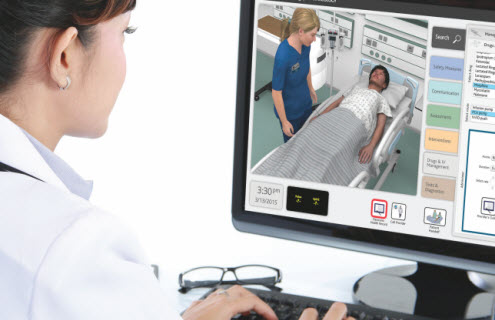
Virtual Simulation
vSim® for Nursing
Develop clinical reasoning skills, competence, and confidence in nursing students with vSim for Nursing.
You’ve likely seen headlines that state “millennials are technology-dependent” or “millennial attention spans are decreasing.” The science behind these claims is lacking and often disputed, though. The impact of technology on the learning environment is unquestionable. However, it’s not just millennial learners that are affected.
Smartphone and computer use are nearly ubiquitous. 77% of adults in the United States own a smartphone – up from 35% of adults in 2011.1 And, more than three billion people are now using the internet.2 The search for information is no longer a time consuming one, with Google at our fingertips and in our very back pockets.
When looking at smartphone usage by age group, of millennials between 18-24 years old, 98% own a smartphone.3 Millennials aged 25-34 years old are following closely behind: 97% own a smartphone (Ibid). And, 96% of Generation Xers (aged between 35-44 years old) own a smartphone.4
What all of this means is that learners today, regardless of age, are constantly seeking new information, are exposed to more information in a day than previous generations, and are more prone to multitasking.5 Adult learning theory dating back to the work of John Dewey, the father of progressive schooling, points to the need for experiential, experimental, and hands-on learning experiences. Because digital media has become all-consuming, emerging learning styles include a balance of experiential learning, guided mentoring, and collective reflection.6 Essentially, in order to meet the needs of modern-day learners, you need to deliver on their terms.
The typical baccalaureate nursing program is comprised of mostly millennial students, but even the 18% of students over 30 years old need more than didactic learning.7 Learners seek to interact with the material in a way they are comfortable with – and that’s online.
In this article, we explore why virtual simulation, a method of treating patients via eLearning, might be the missing piece in your nursing curriculum.
Today, nursing programs rely most heavily on educational technologies like videos, online or distance learning, virtual simulation, and adaptive quizzes and tests.8

Within the next five years, nursing programs are predicted to adopt more advanced learning technologies, such as data analytic tools, mobile apps, and virtual reality.10 The primary reasons behind adopting these technologies are:11
Nursing programs that have larger numbers of enrolled students tend to adopt new technologies more readily, compared to nursing programs that accept fewer students.12 It’s all about economy of scale.
If you’re a small organization, virtual simulation will allow you to leapfrog into new technology and leverage it where human teaching resources are not available. Online training methods can reduce the overall time and cost of a lesson, while maintaining learner satisfaction, confidence, and learning outcomes.13
David Kolb first published his experiential learning theory in 1984, based on the earlier works of John Dewey.14 His four-stage cycle of learning, and four learning styles that he defined, still heavily influence educational courses today. We, at Laerdal, were so inspired by his model that we used it as the basis to create our model, the Circle of Learning.
Kolb’s experiential learning cycle defines four stages that a learner should progress through:
Essential to this theory is the idea that a student must progress through all four stages in order to effectively learn. This implies that no teaching strategy on its own should be the be-all and end-all to effective teaching. For nursing curricula, it is the combination of didactic, hands-on training, simulation, and clinical experience that prove most effective.
Virtual simulation allows learners to treat a virtual patient, gathering their medical history and practicing patient-centered care, without the threat of patient harm. Learners are immersed in an online experience that accomplishes the Reflective Observation stage of Kolb’s cycle. Drawing from textbook and lecture content, learners are engaged in the scenario and make critical decisions about the patient’s care.
Experts have recommended virtual patients as a learning activity that can support nursing students in their scientific knowledge, while helping them to integrate theory into practice.15 The repeatability of the scenarios, in conjunction with the debriefing, allows learners to back-track each decision and compare it to evidence-based practices and protocols.
Virtual simulation affords learners a chance to test their knowledge before participating in a full-fledged simulation and, more importantly, before they step foot into a hospital.
As the internet has grown into the mammoth source that it is today, the applications and effectiveness of eLearning have continued to improve. Research has shown that up to 60% better consistency of learning can be achieved through technology-based training.16

Virtual simulation, one of the most prominent forms of eLearning in the field of nursing education, requires learners to draw on what they’ve been taught and begin testing the application of their skills. Each scenario follows a storyline, integrating video, patient interactions, and pre- and post-simulation quizzes. While achieving the benefits of eLearning, virtual simulations that include the element of story provide additional advantages to the learning experience.
“Simulation and [stories] can move faculty from simply depositing content to using content in different creative ways as part of their teaching agenda and, ultimately, to match curriculum to course learning outcomes,” says Elaine Tagliareni, EdD, RN, CNE, FAAN, and Susan Forneris, PhD, RN, CNE, CHSE-A, from the National League for Nursing (NLN).18
Learners that can follow a story, from start to finish, and see the results of their decisions and actions will be better able to conceptualize safe practices. Virtual simulation provides a safe, effective, and simple online environment to practice critical-thinking and decision-making skills that every nurse needs.